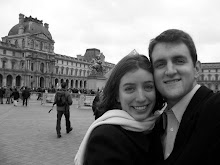.jpg) Living in a little corner of Normandy, we find ourselves constantly discovering new things about this area and its rich history. I had long heard about a castle in Tourlaville (basically a suburb of Cherbourg) so we took the Harpers there to visit on a lazy Sunday afternoon. We ran around the grounds, enjoying the beautiful gardens and scenery, and we determined to come back the next day for a free visit of the castle.
Living in a little corner of Normandy, we find ourselves constantly discovering new things about this area and its rich history. I had long heard about a castle in Tourlaville (basically a suburb of Cherbourg) so we took the Harpers there to visit on a lazy Sunday afternoon. We ran around the grounds, enjoying the beautiful gardens and scenery, and we determined to come back the next day for a free visit of the castle..jpg)
.jpg) The next day we participated in the two hour guided tour, and since it was in French, we were thankful to have the help of Jocelyn Manceau, a friend and assistant hired by Areva to help us with our transition to this country. She translated for us the long and surprising story of the Chateau des Ravalets. To make a long story short, the Lord of Tourlaville, Jean II de Ravalet built this Renaissance castle in the sixteenth century on the site of a medieval manor. Jean II presented it to his nephew, Jean III, whose children, Julien and Marguerite, are the subject of its most famous story. Julien and Marguerite were accused of "loathsome deeds" and were decapitated in Paris in 1603 by order of the the king Henri IV, who was heavily influenced to do so by the queen, Marie de Medicis. Their story can be found at:
The next day we participated in the two hour guided tour, and since it was in French, we were thankful to have the help of Jocelyn Manceau, a friend and assistant hired by Areva to help us with our transition to this country. She translated for us the long and surprising story of the Chateau des Ravalets. To make a long story short, the Lord of Tourlaville, Jean II de Ravalet built this Renaissance castle in the sixteenth century on the site of a medieval manor. Jean II presented it to his nephew, Jean III, whose children, Julien and Marguerite, are the subject of its most famous story. Julien and Marguerite were accused of "loathsome deeds" and were decapitated in Paris in 1603 by order of the the king Henri IV, who was heavily influenced to do so by the queen, Marie de Medicis. Their story can be found at:http://www.ville-cherbourg.fr/uk/tourism_discovery/history/marguerite_and_julien_de/marguerite_and_julien_de/default.asp
Since it was built, the castle has changed hands, been damaged, survived through the Revolution, and been restored many times. Along its long history it was used as a farm, later a hospital, and eventually occupied successively by French, German, and American troops. Above you see the "blue bathroom" on the left and a painting of Marguerite on the right. The massive garden was designed and added in the late 1800s. It was purchased by the Town of Cherbourg in 1935. It is still in a state of restoration. The gardens are open seven days a week, with some of the most beautiful flowers we've seen in Cherbourg..jpg)
.jpg)
.jpg)
.jpg)
.jpg)
.jpg)
.jpg)
.jpg)
.jpg)
.jpg)
.jpg)
.jpg)
.jpg)
.jpg)
.jpg)
.jpg)
.jpg)
.jpg)
.jpg)
+Les+Baux-de-Provence.jpg)
+Les+Baux-de-Provence.jpg)
+Les+Baux-de-Provence.jpg)
+Les+Baux-de-Provence.jpg)
+Les+Baux-de-Provence.jpg)
+Arles.jpg)
+Arles.jpg)
+Arles.jpg)
+Arles.jpg)
+Arles.jpg)
+Pont+du+Gard.jpg)
+Pont+du+Gard.jpg)
+Pont+du+Gard.jpg)
+Pont+du+Gard.jpg)
+A+field+of+sunflowers.jpg)
+A+field+of+sunflowers.jpg)
+A+field+of+sunflowers.jpg)
+A+field+of+sunflowers.jpg)
+A+field+of+sunflowers.jpg)
+St.+Remy-de-Provence.jpg)
.jpg)
.jpg)
.jpg)
.jpg)
.jpg)
.jpg)

.jpg)
.jpg)
.jpg)
.jpg)
.jpg)
.jpg)
.jpg)
.jpg)
.jpg)
.jpg)
.jpg)